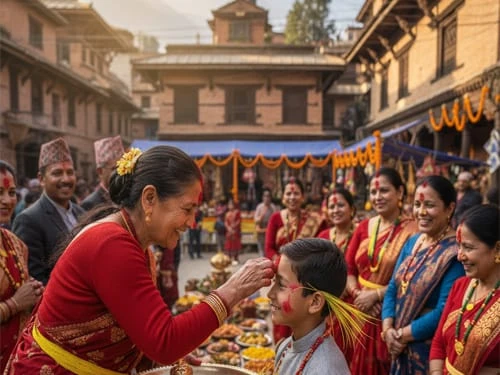Which side of Everest is better, north or south?
The South Face of Mount Everest is normally considered better. The major reasons for this popular choice are given below:
- The South Face of Mount Everest is preferred due to its High Success Rate. In comparison to the Mount Everest North Face, the South side has given a higher success rate till now.
- South Side also has well-established infrastructure options. This includes camps, fixed ropes, and support with better rescue options.
- Everest Base Camp trekking from Nepal offers the mesmerizing cultural experience of Sherpa Villages. The rich culture and scenic approach are must-talk-about things in this region.
- Though both sides experience extreme cold, the South normally has predictable weather. Especially in May, which is a peak time for Mount Everest Nepal.
- Helicopter rescue is possible at the Everest South Base Camp in the event of an emergency.
- Meanwhile, the North Side has fewer climbers due to strict regulations in Tibet.
- Everest North Face is a remote route with very challenging terrain.
Hence, South Col is famous for the Everest trekking in Nepal.
History and famous climbs
The South Face of Everest, accessed from Nepal, is popular for the first ever summit in 1953 by Sir Edmund Hillary and Tenzing Norgay Sherpa. Meanwhile, the summit of the North Face is often considered challenging, with a remote and solitary experience.
Back in 1953, Sir Edmund Hillary and Tenzing Norgay Sherpa made the first ever summit via Southeast Ridge. Since then, this route has been famous amongst climbers.
Similarly, in 1975 Doug Scott and Dougal Haston became the first two Brits to summit the highest peak from the same ridge. This route is also popular as Khumbu Icefall, Western Cwm, Lhotse Face, South Col, and Hillary Step.
Talking about the Mount Everest North Face, back in 1960, the Chinese team made the first ever ascent of the North Ridge. In 1980, Reinhold Messner reached the summit solo without supplementary oxygen or any support via the North Col. This route is also known as the Three Steps.
South Face via Khumbu Nepal
Mount Everest South Face is the most popular route for trekking to the highest peak. Actually, it is a route via Khumbu Nepal. For many years, this has been a popular choice due to various reasons described above. Here is a quick explanation on how you can get there.
Base Camp to Khumbu Icefall
Your journey starts from Kathmandu to Lukla flight. As you land at the Lukla Airport, you will enjoy amazing scenic beauty. Then, you need to trek towards Everest Base Camp at 5364 meters. This is a perfect place for acclimatization. It is located on the Khumbu Glacier.
Do you know about the deadliest section of this region, that is the Khumbu Icefall? It has shifting ice towers and requires an early morning crossing. This helps you escape the risk of collapse.
Western Cwm, Lhotse Face, South Col
It is a broad, flat glacial valley. It is also called the valley of silence due to the calm winds. From there, you will lead up to Lhotse face, Camp III, and finally the South Col. The path requires walking with a rope walk in steep ice walls.
South Col is a high-altitude camp at 7906 meters before the summit push. It is also an entry point to the Death Zone. From here, you will move to Hillary Step.
Hillary Step and Summit
Hillary Step is named after Sir Edmund Hillary. It used to be a 12-meter vertical rock wall, but it collapsed later. After the 2015 earthquake changes, this region is now a rocky slope.
Finally, you will be at the highest point on Earth, Mount Everest, at 8848 meters.
North Face Tibet China via Rongbuk Glacier
Mount Everest North Face is also a good choice for Everest trekking. But, it is less popular and has a smaller crowd than the South Side. It is an Everest route from Tibet that carries lots of challenges. Here is how you can summit Everest from the North Side, have a look:
Base Camp to Advanced Base Camp
First, you need to reach Base Camp, located near Rongbuk Monastery. You can also reach here by vehicle. You will find an intermediate camp midway between the base camp and the advanced base camp. This is a rest point.
Then you will do trekking for the Advanced Base Camp at an altitude of 6400 meters. Actually, it is situated below North Col. This place offers amazing views of East Rongbuk Glacier and the North Face.
North Col, Three Steps, Summit Pyramid
North Col is at 7000 meters, where trekkers use a fixed rope to ascend a steep snow slope. It acts as Camp I on the North Route. Then, you will face a series of rocky outcrops at the northeast ridge. The first step has a steep rocky section. The second step is the most difficult step with a metal ladder. Lastly, the third step is less technical but demanding in thin air.
Finally, you will be at the final snow and rock ridge leading to the summit. This part is quite risky with high winds and extreme altitude.
Political and travel access differences
Mount Everest North Face Vs South Face includes variations in political and travel access. Actually, the South Col route is a journey via Nepal that requires a specific permit and liaison officer. Nepal’s Ministry of Tourism and Sagarmatha National Park look after this matter.
Meanwhile, North Col (accessed via Tibet) is handled by the China Tibet Mountaineering Association. It requires permits like a Tibetan Travel Visa and Military Clearance.
Talking about travel access, the South Col is reached via several days of trekking in the mountain villages of Nepal. On the other hand, North Col (Tibet) is accessible by vehicle.
Difficulty and Dangers
Though climbing Mount Everest via all routes is a tough task in itself, the North Face is considered more difficult and risky. Lack of infrastructure, strict regulations, risky topography, and fewer crowds make the journey dangerous. Also, the success rate of North Col is lower than South Col.
Mount Everest North Face via Khumbu Nepal has a higher success rate with a crowd in peak season (May). Since this route is famous for summiting Everest, there is normally good planning and preparation. With experienced Sherpas, a tour guide, porters, and a good trek management company, you can conquer the highest peak smoothly. This route also offers a fixed rope system and an emergency rescue facility.
Which face of Everest is harder to climb?
The North Face via Tibet is harder to climb. It faces more steep climbs, harsher weather, and limited route options. Also, the regulations are strict with limited climbing permission. The facilities and infrastructure are limited, causing more chances of accidents and danger. Since this place is more focused on protecting the religious values of the mountains, this route may not allow you to explore the region thoroughly.
Also, summiting through the North side is isolated and has less support. You may be stuck in the journey, but there is no effective rescue system. The altitude is very high, with fewer preparations for trekkers. So, the North Face of Everest is harder than the South Face via Nepal.
What is the 2 pm rule on Everest?
The 2 PM rule on Everest is a safety guideline that indicates that the climbers should start their descent by 2 PM, even if they are close to the summit. This has been a standard practice for many years.
Actually, this rule was enforced due to unpredictable high-altitude weather. It primarily minimizes the risk of climbers being caught in a blizzard or extreme weather while descending. This is a safety rule that aims at preventing accidents and ensuring the well-being of climbers in such a challenging environment.
Do you know that many climbers have lost their lives ignoring the 2 PM rule on Everest? For safety reasons, the expedition leaders are given strict guidelines about this rule. Also, this rule helps to move with daylight as the journey after sunset is quite risky. Weather condition changes rapidly in the Himalayas, which requires avoiding the dark path. Night storms are more dangerous than daytime ones.
What is the difference between the North and South base camps on Everest?
North Base Camp and South Base Camp are different in terms of altitude, location, and many other factors. Check out the key differences below:
North Base Camp
- It is located at 5360 meters, which is 17598 feet
- It is used by climbers attempting the Southeast Ridge route
- More accessible base camp for trekking and acclimatization
- Easier to reach on foot via Lukla
South Base Camp
- It is located at 5150 meters, which is 16900 feet
- It is used by climbers attempting the Northeast Ridge route
- It is accessible by road from Lhasa, and then a short trek to Rongbuk Monastery
- It is normally a higher elevation base camp, so it may not be suitable for those who want a closer summit of Everest.
Climate Preference
No matter whether you choose the North Face or the South Face of Everest, the right choice of climate will help you enjoy a smooth journey. Normally, the climate preference for the Everest summit is the Spring and Autumn seasons. May is the peak month with a good number of climbers in the base camps.
March, April, and May are mostly competitive and safe from a weather point of view. Similarly, September, October, and November can also be safe and enjoyable with a supportive climate.
However, it is better to avoid the monsoon and winter seasons. Heavy downpour and snowfall in winter can be very dangerous at such a high altitude. So, you don't have to worry about which is the best time for Everest trekking, just opt for Spring or Autumn season of Nepal.
Travel Tips
Everest Summit is a risky task that requires proper travel guidelines and preparations. No matter whether you choose North Col or South Col, travel tips are applicable for both routes. Here are the necessary travel tips, have a look:
- You should train yourself for high altitude and endurance
- You should acclimate properly
- Hire experienced guides and porters. Sherpas are the right choice
- You should start the summit push early, from midnight to 2 am
- Better to use certified oxygen equipment
- Follow route discipline and rope safety
- You should stay hydrated and consume high-energy food
- Stay calm and focus on your path
- Be aware of altitude sickness
Following the above travel tips, you will enjoy a brilliant Everest trekking. With the right guidelines, you not only have a safe journey but also a memorable, fun trip.
Well, the Mount Everest summit is a big dream and a courageous step that people around the world are fond of. You can either proceed on this trek from the North Face via Tibet or the South Face via Nepal. Both routes require good preparation, planning, and physical fitness. However, the Everest North Face is a more popular option, considering more planned and organized trekking. Also, it has a higher success rate than The North Face.




